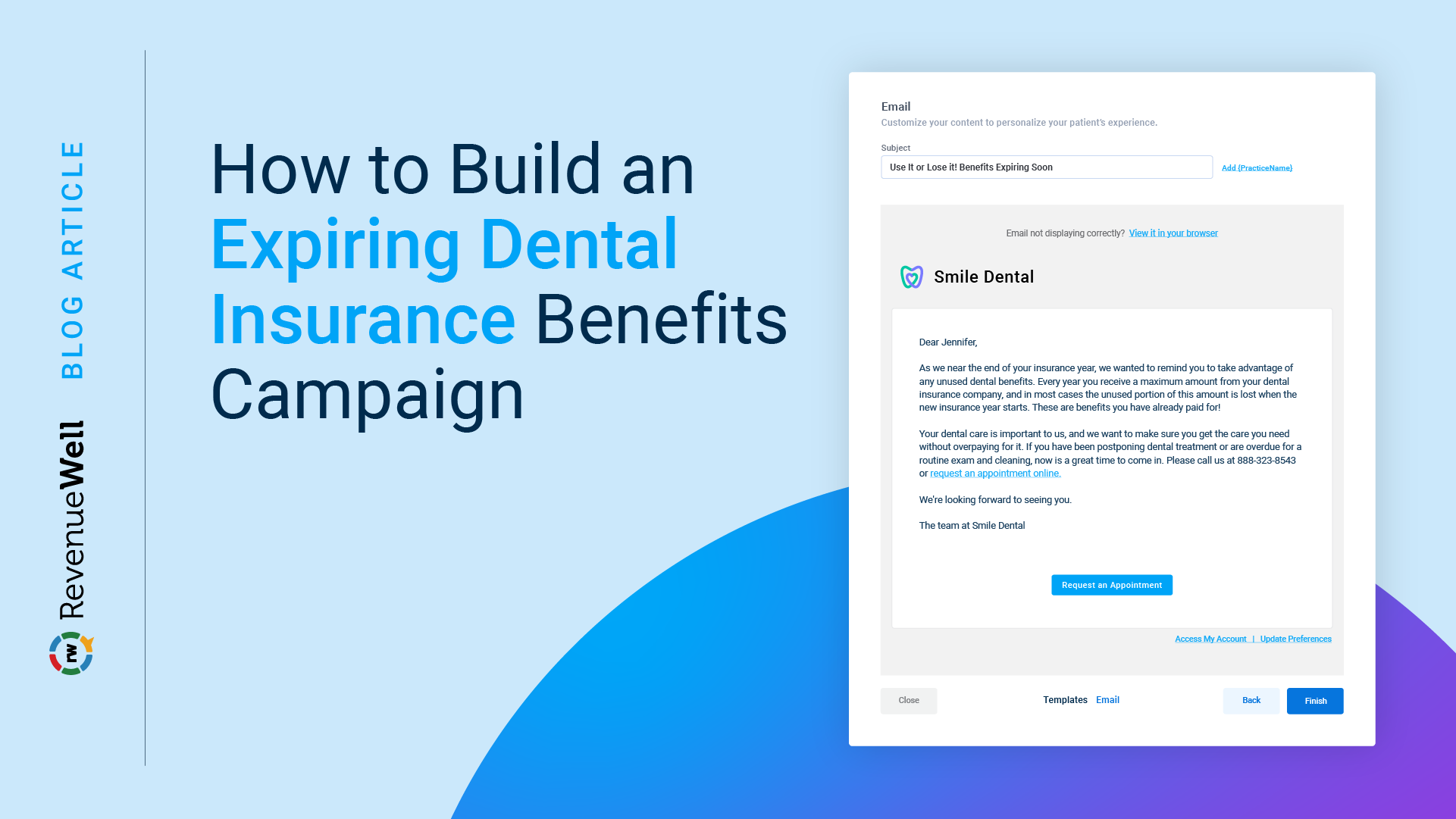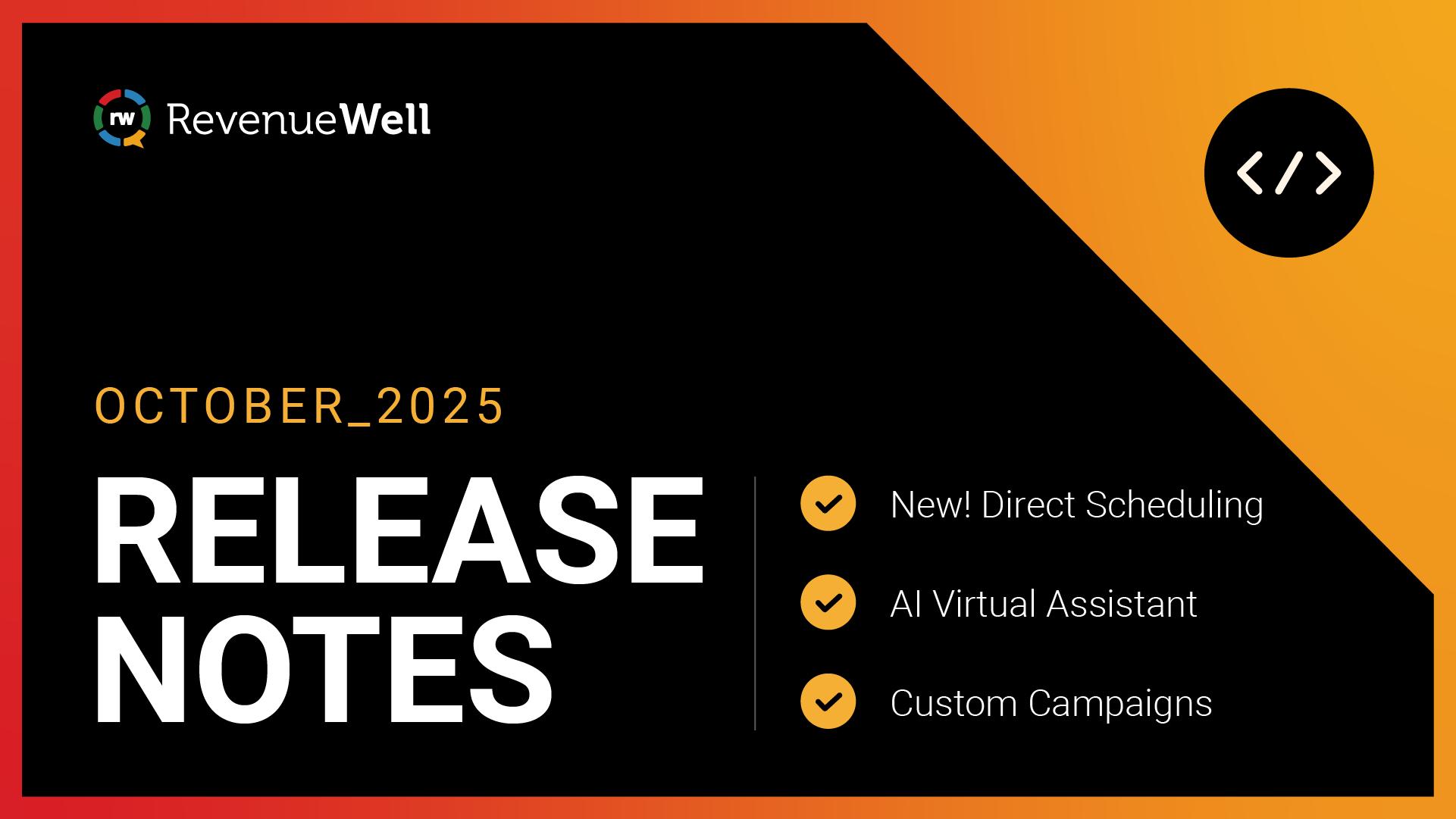How to Build an Expiring Dental Insurance Benefits Campaign

Around this time of the year, it always feels like the months start to fly by, and before you know it, you've reached the end of the year. Many of your patients may have unused dental insurance benefits that will expire soon. According to the nonprofit Employee Benefits Research Institute, more than 40% of workers with FSAs forfeited some of their contributions by not using up all their funds by the spending deadline. A timely expiring dental insurance benefits reminder campaign helps patients make the most of their insurance while also helping your practice fill its schedule during the busy fall and holiday months.
Here’s how to easily build and implement an expiring dental insurance benefits campaign to send to your patients.
Step 1: Identify Eligible Patients
The first step in creating your expiring benefits campaign is to identify which patients have unused dental benefits that are set to expire at the end of the year. Most dental insurance plans run on a calendar year, so benefits typically reset on January 1. Here are some patient groups you can target:
- Patients who have not completed all their covered cleanings and exams.
- Patients with pending or incomplete treatment plans that can be covered or partially covered by their insurance and/or FSA or HSA funds.
- Patients who haven’t visited your practice in six months or more who have not reached their yearly insurance maximum.
Tip: One way to identify patient groups is using your patient engagement system. Some systems have advanced filtering options for insurance that make it easy to pull patient lists based on the filters you choose. You can use filter options like patients who have expiring insurance benefits in the next (x) months and have a remaining benefits balance of ($) amount and/or by insurance carrier.
Step 2: Create a Compelling Message
Once you’ve identified your patients, it’s time to craft messaging that motivates them to act. Your message should highlight:
- Urgency: Let patients know that their unused dental insurance will expire at the end of the year, and that FSA funds don’t roll over.
- Benefits: Remind them that they’ve already paid for their insurance and/or contributed to their FSA and/or HSA accounts so they should take advantage of what they’ve put money into. You can also add a sentence about taking care of their oral health since it does impact their overall wellness.
- Treatments: Highlight specific treatments they should come in for such as a cleaning and/or a proposed treatment plan that insurance may cover.
- Call to action (CTA): Encourage patients to book an appointment before the year ends. Include a CTA button that says “Book Now” in your emails that takes them directly to your online scheduling tool, if available.
Here’s a sample message you can use or edit. "Time is running out! Don’t let your dental insurance benefits go to waste. Book your appointment today and use your remaining benefits before they expire on December 31st!"
Tip: Emphasize dates for clarity. Being timebound can motivate patients to plan, especially as they get closer to the holiday season and schedules get busy.
Step 3: Choose Your Marketing Channels
To increase awareness, use multiple channels to reach your patients. Here are some ways you can spread the word.
- Email marketing: Send personalized emails to the patient segments you’ve identified who have unused benefits or could benefit from this communication. Segment your list using some of the examples that were shared earlier.
- Text reminders: Use texting for a quick reminder to patients who haven’t responded to emails or calls or in conjunction with your email marketing. Texts have a 98% open rate and can prompt immediate action.
- Phone calls: For patients who prefer phone calls and/or those with outstanding treatment plans, a personal phone call can be an effective way to convey the importance of using their benefits.
- Social media: Use Facebook and/or Instagram to create posts that remind patients that their benefits might be expiring soon and enforce the urgency to book before the holiday season.
- Direct mail: A postcard can be an additional touchpoint for patients who may have missed your text or email. Why direct mail? Some of your patients may prefer it, be less tech savvy, or may not have regular online access so this is still a good way to keep patients informed.
- Website: You can add a banner and/or pop up about expiring benefits on your website like your homepage with a CTA to where they can book an appointment online.
- Office TV: If you have a smart TV service like RevenueWell TV, you can use it to promote your campaigns, like an expiring benefits reminder.
- Countertop displays: If your front office countertop has space, you can add a small sign reminding patients to use their remaining insurance benefits before they expire. This is a good way to spark a conversation at the front desk.
In your patient profiles, be sure those patients you’re contacting have indicated they prefer receiving communications via email, text, phone, and/or direct mail. That way you’re not bombarding them with messages and you’re more likely to get a response through the channels they engage with.
Tip: If your practice has a blog, consider writing a short post about why it’s important for patients to use their benefits before they expire. Include a CTA that makes it easy for them to schedule an appointment directly from that post. You can cross-promote the blog post on social channels, include it in a personalized email, and even your newsletter.
Step 4: Set Up and Automate Your Campaign Schedule
Timing is of the essence for an expiring benefits campaign. Start reaching out to patients near the end of summer and/or end of Q3 or early Q4 and maintain regular follow-ups to ensure your message is seen and patients schedule an appointment. Remember, the rule of 7. For many patients, it can take up to 7 messages to resonate. Here’s one way to approach it using a patient engagement system.
- First round: At the end of summer or first week of fall, send out your first email and/or direct mail piece. This is a soft reminder for patients to consider using their remaining benefits soon.
- Second round: During October, increase the frequency of your messaging. This should include a mix of follow-up emails, social media posts, and text reminders. For example, you can send 1 email each week, do 1-2 social media posts each week, and send 1 text reminder each week. This message should be a little more urgent than the first round of communications. Encourage patients to make their appointments sooner rather than later because they’ll have a better chance of getting one that works for their schedule instead of having to shuffle around activities and other appointments to accommodate their dental one.
- Last Round: By early to mid-November, send out final reminders urging patients to book now to avoid losing unused funds or not taking advantage of services that are covered. If your practice will be closed during specific holidays in December, be sure to share the dates and times you’ll be open and closed, so patients can schedule their appointment accordingly. Send a couple of emails and/ or texts to drive home the message.
Be mindful of how many communications you’re sending to these patients so you’re not sending multiple messages on the same day and potentially overwhelming them with content which could cause them to unsubscribe from your communication.
Tip: Some patient engagement systems have a ready-made expiring dental insurance benefits template you can use. Instead of building one from scratch, you can use that template and update the content and/or visual.
Step 5: Monitor and Analyze Results
To make sure your expiring benefits reminder campaign is effective, you’ll need to track its success. Some key performance indicators (KPIs) to monitor include:
- Appointment bookings: Track the number of appointments scheduled directly from your campaign.
- Open and response rates: Measure how many patients opened your emails or clicked on the “Book Now” link.
- Conversions from calls or texts: Track the number of patients who responded to phone calls or text messages.
You don’t have to monitor this manually. Your patient engagement system can track campaign metrics, and some systems have a more advanced analytics tool to help understand if your campaigns are influencing important practice metrics like production and case acceptance.

Tip: Keep a record of the patients who didn’t schedule appointments based on your campaign so you can follow up with personalized reminders in the new year. This message can remind patients to use their funds earlier in the year to avoid losing money and delaying care.
Once the campaign is over, follow up with a thank-you message to those who scheduled appointments from this campaign, and remind them of the benefit of regular checkups throughout the year. Encourage them to schedule their appointments earlier in the year, especially if some of your patients wait until the last minute to make appointments. An expiring benefits campaign is one “seasonal” campaign to always include in your patient communication activities to help fill your schedule during a hectic season for many people. The key is to plan early, figure out what went well and what could be improved, and apply it to next year’s campaign, and you can use these steps to build an effective campaign.
Next Recommended Read: How to Build Dental Marketing Campaigns That Retain Patients




